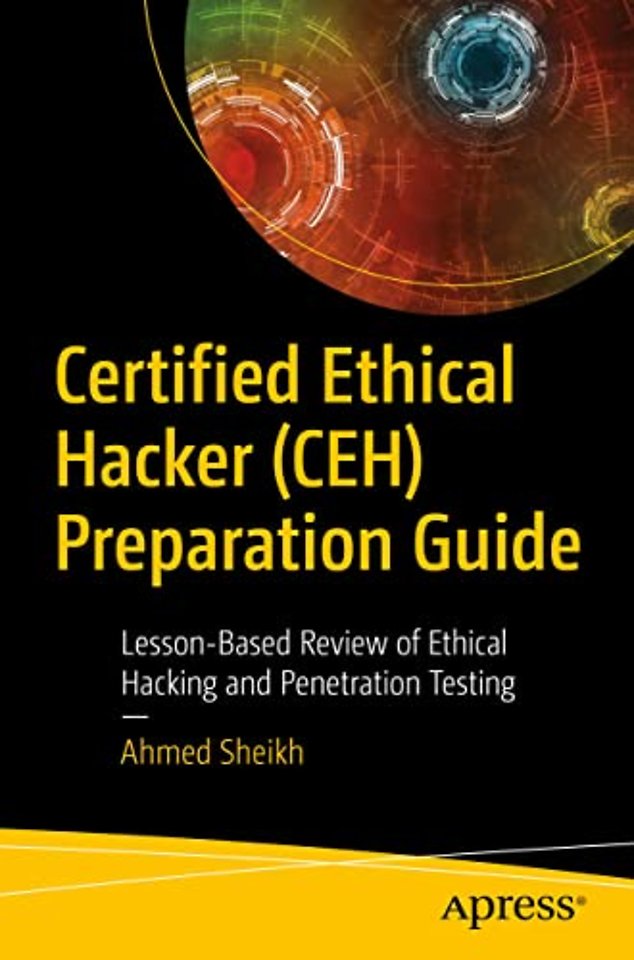Certified Ethical Hacker (CEH) Preparation Guide
Lesson-Based Review of Ethical Hacking and Penetration Testing
Paperback Engels 2021 1e druk 9781484272572Samenvatting
Know the basic principles of ethical hacking. This book is designed to provide you with the knowledge, tactics, and tools needed to prepare for the Certified Ethical Hacker(CEH) exam—a qualification that tests the cybersecurity professional’s baseline knowledge of security threats, risks, and countermeasures through lectures and hands-on labs.
You will review the organized certified hacking mechanism along with: stealthy network re-con; passive traffic detection; privilege escalation, vulnerability recognition, remote access, spoofing; impersonation, brute force threats, and cross-site scripting. The book covers policies for penetration testing and requirements for documentation.
This book uses a unique “lesson” format with objectives and instruction to succinctly review each major topic, including: footprinting and reconnaissance and scanning networks, system hacking, sniffers and social engineering, session hijacking, Trojans and backdoor viruses and worms, hacking webservers, SQL injection, buffer overflow, evading IDS, firewalls, and honeypots, and much more.
What You Will learn
- Understand the concepts associated with Footprinting
- Perform active and passive reconnaissance
- Identify enumeration countermeasures
- Be familiar with virus types, virus detection methods, and virus countermeasures
- Know the proper order of steps used to conduct a session hijacking attack
- Identify defensive strategies against SQL injection attacks
- Analyze internal and external network traffic using an intrusion detection system
Who This Book Is For
Security professionals looking to get this credential, including systems administrators, network administrators, security administrators, junior IT auditors/penetration testers, security specialists, security consultants, security engineers, and more
Specificaties
Lezersrecensies
Inhoudsopgave
Identify the different types of hacker attacks.
Chapter 2. Footprinting and Reconnaissance & Scanning Networks
Identify the specific concepts associated with Footprinting.
Describe information gathering tools and methodology.
Explain DNS enumeration.
Perform active and passive reconnaissance.
Recognize the differences between port scanning, network scanning and vulnerability scanning.
Identify TCP flag types.
Identify types of port scans.
Identify scanning countermeasures
Chapter 3. Enumeration
Explain enumeration techniques.
Recognize how to establish sessions.
Identify enumeration countermeasures.
Perform active and passive enumeration.
Chapter 4. System Hacking
Identify different types of password attacks.
Use a password cracking tool.
Identify various password cracking countermeasures.
Identify different ways to hide files.
Recognize how to detect a rootkit.
Identify tools that can be used to cover attacker tracks.
Chapter 5. Trojans and Backdoor Viruses and Worms
Explain how a Trojan infects a system.
Identify ports used by Trojans and Trojan countermeasures.
Identify the symptoms of a virus.
Describe how a virus works.
Identify virus types, virus detection methods, and virus countermeasures.
Chapter 6. Sniffers and Social Engineering
Identify types of sniffing, and protocols vulnerable to sniffing.
Recognize types of sniffing attacks.
Identify methods for detecting sniffing.
Identify countermeasures for sniffing.
Identify different types of social engineering, and social engineering countermeasures.
Chapter 7. Denial of Service
Identify characteristics of a DoS attack.
Analyze symptoms of a DoS attack.
Recognize DoS attack techniques.
Identify detection techniques, and countermeasure strategies.
Chapter 8. Session Hijacking
Identify the proper order of steps used to conduct a session hijacking attack.
Recognize different types of session hijacking.
Identify TCP/IP hijacking.
Describe countermeasures to protect against session hijacking.
Chapter 9. Hacking Webservers
Define Web Server architecture.
Explain Web server vulnerabilities.
Explore various Web Server attacks.
Chapter 10. Hacking Web Applications
Identify Web application components.
Describe Web application attacks.
Identify countermeasures.
Chapter 11. SQL Injection
Examine SQL Injection Attacks.
Identify defensive strategies against SQL injection attacks.
Chapter 12. Hacking Wireless Networks
Identify various types of wireless networks.
Identify authentication methods, and types of wireless encryption.
Explain the methodology of wireless hacking.
Apply wireless commands and tools.
Examine plain text wireless traffic, wired equivalent privacy (WEP)
Chapter 13. Evading IDs, Firewalls, and Honeypots
Identify intrusion detection systems, and techniques.
Identify the classes of firewalls.
Define a honeypot.
Analyze internal and external network traffic using an intrusion detection system.
Chapter 14. Buffer Overflow
Define a buffer overflow.
Identify a buffer overflow.
Identify buffer overflow countermeasures.
Chapter 15. Cryptography
Recognize public key cryptography.
Identify a digital signature.
Define a message digest.
Define secure sockets layer (SSL).
Analyze encrypted email.
Chapter 16. Penetration Testing
Identify types of security assessments.
Identify steps of penetration testing.
Examine risk management.
Identify various penetration testing tools.
Anderen die dit boek kochten, kochten ook
Rubrieken
- advisering
- algemeen management
- coaching en trainen
- communicatie en media
- economie
- financieel management
- inkoop en logistiek
- internet en social media
- it-management / ict
- juridisch
- leiderschap
- marketing
- mens en maatschappij
- non-profit
- ondernemen
- organisatiekunde
- personal finance
- personeelsmanagement
- persoonlijke effectiviteit
- projectmanagement
- psychologie
- reclame en verkoop
- strategisch management
- verandermanagement
- werk en loopbaan







